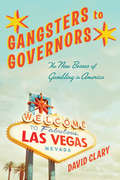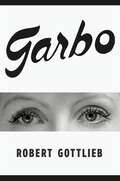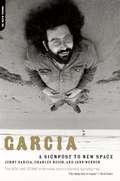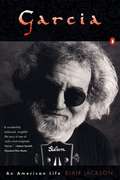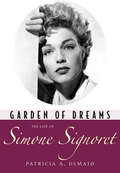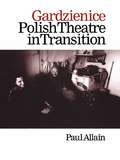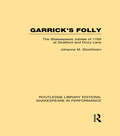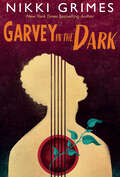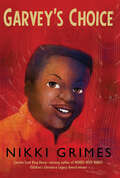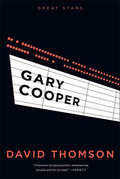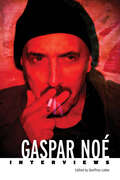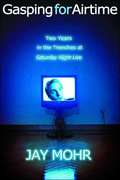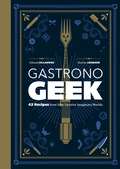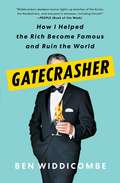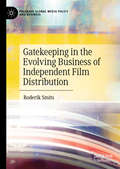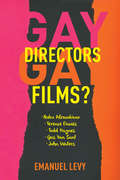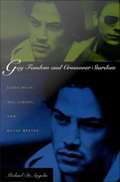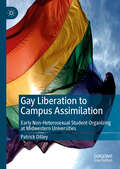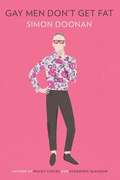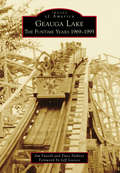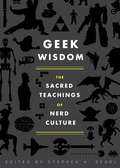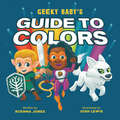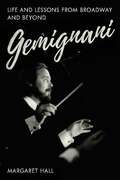- Table View
- List View
Gangsters to Governors: The New Bosses of Gambling in America
by David ClaryGenerations ago, gambling in America was an illicit activity, dominated by gangsters like Benny Binion and Bugsy Siegel. Today, forty-eight out of fifty states permit some form of legal gambling, and America’s governors sit at the head of the gaming table. But have states become addicted to the revenue gambling can bring? And does the potential of increased revenue lead them to place risky bets on new casinos, lotteries, and online games? In Gangsters to Governors, journalist David Clary investigates the pros and cons of the shift toward state-run gambling. Unearthing the sordid history of America’s gaming underground, he demonstrates the problems with prohibiting gambling while revealing how today’s governors, all competing for a piece of the action, promise their citizens payouts that are rarely delivered. Clary introduces us to a rogue’s gallery of colorful characters, from John “Old Smoke” Morrissey, the Irish-born gangster who built Saratoga into a gambling haven in the nineteenth century, to Sheldon Adelson, the billionaire casino magnate who has furiously lobbied against online betting. By exploring the controversial histories of legal and illegal gambling in America, he offers a fresh perspective on current controversies, including bans on sports and online betting. Entertaining and thought-provoking, Gangsters to Governors considers the past, present, and future of our gambling nation. Author's website (http://www.davidclaryauthor.com)
Garbo
by Robert GottliebA New York Times Book Review Editors' Choice | One of Literary Hub's most anticipated books of 2021Award-winning master critic Robert Gottlieb takes a singular and multifaceted look at the life of silver screen legend Greta Garbo, and the culture that worshiped her.“Wherever you look in the period between 1925 and 1941,” Robert Gottlieb writes in Garbo, “Greta Garbo is in people’s minds, hearts, and dreams.” Strikingly glamorous and famously inscrutable, she managed, in sixteen short years, to infiltrate the world’s subconscious; the end of her film career, when she was thirty-six, only made her more irresistible. Garbo appeared in just twenty-four Hollywood movies, yet her impact on the world—and that indescribable, transcendent presence she possessed—was rivaled only by Marilyn Monroe’s. She was looked on as a unique phenomenon, a sphinx, a myth, the most beautiful woman in the world, but in reality she was a Swedish peasant girl, uneducated, naïve, and always on her guard. When she arrived in Hollywood, aged nineteen, she spoke barely a word of English and was completely unprepared for the ferocious publicity that quickly adhered to her as, almost overnight, she became the world’s most famous actress.In Garbo, the acclaimed critic and editor Robert Gottlieb offers a vivid and thorough retelling of her life, beginning in the slums of Stockholm and proceeding through her years of struggling to elude the attention of the world—her desperate, futile striving to be “left alone.” He takes us through the films themselves, from M-G-M’s early presentation of her as a “vamp”—her overwhelming beauty drawing men to their doom, a formula she loathed—to the artistic heights of Camille and Ninotchka (“Garbo Laughs!”), by way of Anna Christie (“Garbo Talks!”), Mata Hari, and Grand Hotel. He examines her passive withdrawal from the movies, and the endless attempts to draw her back. And he sketches the life she led as a very wealthy woman in New York—“a hermit about town”—and the life she led in Europe among the Rothschilds and men like Onassis and Churchill. Her relationships with her famous co-star John Gilbert, with Cecil Beaton, with Leopold Stokowski, with Erich Maria Remarque, with George Schlee—were they consummated? Was she bisexual? Was she sexual at all? The whole world wanted to know—and still wants to know.In addition to offering his rich account of her life, Gottlieb, in what he calls “A Garbo Reader,” brings together a remarkable assembly of glimpses of Garbo from other people’s memoirs and interviews, ranging from Ingmar Bergman and Tallulah Bankhead to Roland Barthes; from literature (she turns up everywhere—in Hemingway’s For Whom the Bell Tolls, in Evelyn Waugh, Graham Greene, and the letters of Marianne Moore and Alice B. Toklas); from countless songs and cartoons and articles of merchandise. Most extraordinary of all are the pictures—250 or so ravishing movie stills, formal portraits, and revealing snapshots—all reproduced here in superb duotone. She had no personal vanity, no interest in clothes and make-up, yet the story of Garbo is essentially the story of a face and the camera. Forty years after her career ended, she was still being tormented by unrelenting paparazzi wherever she went.Includes Black-and-White Photographs
Garcia: A Signpost to New Space
by Jann Wenner Jerry Garcia Charles ReichJerry Garcia (1942-1995) is an American icon. The guitarist and de facto leader of the Grateful Dead was a gregarious talker, keenly engaged with the new world exploding around him. In 1972, Garcia was visited by Charles Reich, a Yale law professor, and Jann Wenner, the founder of Rolling Stone. Garcia was just thirty-one years old but already viewed--to his lasting dismay--as a social avatar for the new sensibility sweeping the land, an anarchist streak with a populist undercurrent that had roots in Ken Kesey's pranksters, the writers of the Beat Generation, and the libertine tradition of the American transcendentalists. In this interview, Garcia reveals how he is a combination of these and other influences, a high-school dropout and autodidact blessed with a gift for eloquent turns of phrase and a refreshing directness. He speaks of the saga of the Grateful Dead and his hoodlum youth growing up in San Francisco's Mission district. He delves into fascinating discourses on the music that shaped his own playing and writing, and freely discusses his use of drugs and explains why he felt it was important to stay high. Like the Grateful Dead's best music, Garcia: A Signpost to New Space is familiar, friendly, and inviting.
Garcia: An American Life
by Blair JacksonHe was there when Dylan went electric, when a generation danced naked at Woodstock, and when Ken Kesey started experimenting with acid. Jerry Garcia was one of the most gifted musicians of all time, and he was a member of one of the most worshiped rock 'n' roll bands in history. Now, Blair Jackson, who covered the Grateful Dead for twenty-five years, gives us an unparalleled portrait of Garcia--the musical genius, the brilliant songwriter, and ultimately, the tortured soul plagued by his own addiction. With more than forty photographs, many of them previously unpublished, Garcia: An American Life is the ultimate tribute to the man who, Bob Dylan said, "had no equal."
Garden of Dreams: The Life of Simone Signoret (Hollywood Legends Series)
by Patricia A. DemaioThe incomparable Simone Signoret (1921-1985), one of the grand actresses of the twentieth century and one of France's most notable stars, considered herself the “oldest discovery” in Hollywood. After years of block-listing during the McCarthy era, she was thirty-eight years old when she entered Hollywood through the back door in the 1959 British blockbuster Room at the Top. Her portrayal of the endearing Alice Aisgill earned her the Academy Award in 1960, the first French actor to win a coveted Oscar. Though a latecomer to Hollywood, Signoret was already an international star who had survived the Nazi occupation of Paris, emerging in 1945 as a beautiful, promising actress capable of communicating more emotion through body language than dialogue alone could achieve. She gained a reputation as the thinking man's sex symbol and in several films portrayed prostitutes with subtlety and depth. She was fiercely protective of her privacy. But after winning the Oscar, she was dragged through the gutter when her second husband, Yves Montand, had a widely publicized affair with Marilyn Monroe. Many attributed her rapid aging and alcoholism to this betrayal. She endured this perception in silence, all the while demonstrating a remarkable capacity to reinvent herself as a bestselling author, respected social activist, and revered actress who remained in the cinema, her “garden of dreams,” for over four decades. Patricia A. DeMaio combines Signoret's courageous story with Montand's biography to reveal new information and insight into Signoret's humanitarian efforts and the vibrant film career that sustained her.
Gardzienice: Polish Theatre in Transition (Contemporary Theatre Studies #Vol. 22)
by Paul AllainIn 1977, the Gardzienice Theatre Association, an experimental theatre company was founded in a tiny Polish village. By 1992 The Observer was hailing "Brilliant Gardzienice...and orgy of joy, anguish, prayer and lamentation performed in candlelight with hurtling energy and at breakneck speed...Physically reckless, thrillingly well sung...On no account to be missed. " Today the Gardzienice Theatre Association is hailed as Poland's leading theatre group, training Royal Shakespeare Company actors and touring the world. Paul Allain describes and analyses their sung performances, strenuous physical and vocal training, and anthropological fieldwork amongst marginalized European minorities. This is one of the first detailed attempts to assess developments in Polish experimental theatres since 1989. The author questions whether those artists can maintain their vision in the face of Poland's economic difficulties and increased commercialization of the arts.
Garrick's Folly: The Shakespeare Jubilee of 1769 at Stratford and Drury Lane (Routledge Library Editions: Shakespeare in Performance)
by Johanne M. StochholmThe great Shakespeare Jubilee festival was held at Stratford, under the direction of David Garrick. The occasion was the dedication of the new town hall and the presentation by Garrick of a statue of Shakespeare. Immense interest, enthusiasm, and controversy were aroused by the plans, which involved not only theatrical and rhetorical festivities but fireworks, processions and a horserace. This book was originally published in 1964 to coincide with the 400th anniversary of Shakespeare’s birth. It describes the festival, which touched heights of success and depths of disaster, its impact on Stratford, its after effects in London, especially theatrical London, where rival managers tried to cash in on Garrick’s idea and where Garrick turned the Stratford failure into resounding success at Drury Lane. The author quotes entertainingly from newspapers, memoirs, and plays, and illustrates her book with contemporary engravings and portraits.
Garth Pig Steals the Show
by Mary RaynerFrom the book: The Pig family has formed a band, but they need one more player. On the very day of their big concert, a hairy horn-blower sticks her long, pointed nose through the door and volunteers to play. William Pig wonders about this mysterious musician who spends most of the performance licking her lips. And when Garth suddenly disappears from his chair, it's up to William to save his little brother and the show. With some creative conducting, he brings the concert to an unforgettable finale. Performing with all the humor and affection of their previous adventures, Mary Rayner's beloved Pig family is sure to receive a hearty "Bravo!" for their latest triumph. Other books about the Pig family are available from Bookshare.
Garvey in the Dark
by Nikki Grimes"Garvey in the Dark is more than a beautifully crafted novel in verse. It&’s a story that faces news headlines and captures the wild emotional roller coaster of the COVID-19 pandemic with honesty and courage. A must-read for young people who lived through the early days of the outbreak as well as those who will be curious about it in years to come." —Kate Messner, New York Times bestselling author&“With deceptive simplicity, Grimes captures characters and emotions by wielding a poetic form—the tanka—with superb and superhuman strength, and the result is a beautiful and brilliant book about how faith, grace, and familial love can help us triumph over adversity...&” —Padma Venkatraman, Walter Award-winning author of The Bridge HomeCapturing the shock and impact of the COVID-19 pandemic through the eyes of Garvey, a beloved character, Nikki Grimes&’s newest novel in verse shows readers how to find hope in difficult times.Garvey&’s finally happy—he&’s feeling close to his father through their shared love of music, bullies are no longer tormenting him, and his best friends Manny and Joe are by his side. But when the schools, stores, and restaurants close because people are getting sick, Garvey&’s improved life goes into lockdown as well. And when Garvey&’s father gets sick, Garvey must find a way to use his newfound musical skills to bring hope to both his father and himself. Moving, powerful, and beautifully told, this remarkable novel shows readers how even small acts have large reverberations, how every person can make a difference in this world, and how—even in the most difficult times—there are ways to reach for hope and healing. Nikki Grimes is a New York Times bestselling author who has won the ALAN Award for outstanding contributions to young adult literature, the Children's Literature Legacy Award, the Virginia Hamilton Award for Lifetime Achievement, and NCTE Award for Excellence in Poetry for Children. She has also received several ALSC Notables, a Coretta Scott King Author Award, Coretta Scott King Author Honors, Boston Globe-Horn Book Honors, a Printz Honor, and a Sibert Honor.
Garvey's Choice
by Nikki GrimesGarvey's father has always wanted Garvey to be athletic, but Garvey is interested in astronomy, science fiction, reading--anything but sports. <P><P>Feeling like a failure, he comforts himself with food. Garvey is kind, funny, smart, a loyal friend, and he is also obese, teased by bullies, and lonely. <P><P>When his only friend encourages him to join the school chorus, Garvey's life changes. The chorus finds a new soloist in Garvey, and through chorus, Garvey finds a way to accept himself, and a way to finally reach his distant father--by speaking the language of music instead of the language of sports. <P>This emotionally resonant novel in verse by award-winning author Nikki Grimes celebrates choosing to be true to yourself.
Gary Cooper (Great Stars)
by David Thomson"Cooper was heroic, of course, in his own mind as much as in his scripts. He was manly, tall, ruggedly handsome. He was a man for a fight." On screen Gary Cooper was the ultimate all-American hero: lean, laconic, and masculine, a lone sheriff battling his enemies in High Noon, or a tough individualist in The Fountainhead. Off-screen he bedded a host of leading ladies and carefully honed his image, making hundreds of movies and winning two Oscars in the process. The acclaimed film writer David Thomson explores the career and the contradictions of "Coop," the star who lived the dream in the golden age of Hollywood.
Gaspar Noé: Interviews (Conversations with Filmmakers Series)
by Geoffrey LokkeSince the release of his breakout film Irréversible in 2002, Gaspar Noé (b. 1963) has been labeled the principal provocateur of twenty-first-century French cinema. While many of the filmmaker’s complex and daring works have been reduced by his critics to their (innumerable) depictions of hallucinogens, violence, and unsimulated sexual intercourse—the latter rendered into vertiginous 3D with his film Love—other viewers have remained in steady awe of Noé’s dizzying camerawork, immersive visuality, and expressive editing. Noé’s cinema greets the short attention spans of digital life with works of extremities and endurance for performers and spectators alike. This first-of-its-kind collection of interviews documents Noé’s engagement with the feverish reception of his work and received ideas about his life and politics. Collecting conversations with critics, scholars, and artists, including fellow directors Matthew Barney, Abel Ferrara, and Harmony Korine, Noé speaks about his process as a writer, director, cinematographer, and editor. Also examined are his engagement with developing film technology and his fascination and indebtedness to past filmmakers such as Pier Paolo Pasolini, Jean Eustache, Stanley Kubrick, and Sam Peckinpah. Noé discusses life in Buenos Aires and emigrating to France, his use of irony and melodrama, and his interest in documentary practices. Throughout, Noé explores his continuing examination of faith and secularism, body and mind, and the politics of spectatorship. Editor Geoffrey Lokke’s introduction provides a close reading of Noé in conversation, assessing what has changed over the years in terms of the filmmaker’s aesthetics and presentation of self, as well as what Noé is reticent to articulate about his life and art.
Gasping for Airtime: Two Years in the Trenches of Saturday Night Live
by Jay MohrWhen 21-year-old Jay Mohr moved from New Jersey to New York City to pursue his dream of stand-up stardom, he never thought the first real job he'd land would be on Saturday Night Live. But, surprisingly, that's just what he did. What followed were two unbelievable, grueling, and exciting years of feverishly keeping pace with his talented cohorts, out-maneuvering the notorious vices that claimed the lives of other cast members, and struggling at all costs for the holy grail of late-night show business: airtime.In Gasping for Airtime, Jay offers an intimate account of the inner workings of Saturday Night Live. He also dishes on the guest hosts (John Travolta, Shannen Doherty, Charles Barkley), the musical guests (Kurt Cobain, Steven Tyler, Eric Clapton), and of course his SNL castmates (Chris Farley, Adam Sandler, Mike Myers, and David Spade). Refreshingly honest and laugh-out-loud funny, this book will appeal both to fans of Jay Mohr and to devotees of Saturday Night Live.
Gastronogeek: 42 Recipes from Your Favorite Imaginary Worlds
by Thibaud Villanova Maxime LéonardFrom Back to the Future to Superman, this cookbook combines gastronomy and geek culture with playful recipes from fifteen fandoms -- perfect for anyone looking to bring more magic and imagination into the kitchen.Presenting pop culture delicacies for both casual and devoted fans, this cookbook includes forty-two recipes to conjure up unbelievable three-course menus influenced by fifteen fandoms from science fiction, fantasy, manga, horror, and comics. Become a gourmet geek with this mouthwatering menu:A delicate "Impossible Soufflé" from Doctor Who"Sanji's Special Pork Steaks" from One PieceThe aptly named "Transylvanian Beef" from Dracula with roast beef, onions, and saffron potatoesA hearty "Vegetables of Yesteryear Pie" from The Lord of the RingsSpecialty sweets and desserts: "Martha Kent's Apricot and Almond Tart," "McFly Cheesecake," or the "Eye of Sauron Sabayon", and more!From comfort food to culinary classics, pop culture chef Thibaud Villanova's imaginative recipes are sure to amaze and delight everyone gathered around the table.
Gatecrasher: How I Helped the Rich Become Famous and Ruin the World
by Ben WiddicombeA smart, gossipy, and very funny examination of celebrity culture from New York&’s premiere social columnist. Ben Widdicombe is the only writer to have worked for Page Six, TMZ, and The New York Times—an unusual Triple Crown that allowed him personal access to the full gamut of Hollywood and high society&’s rich and famous, from billionaires like Rupert Murdoch, Donald Trump, and the Koch brothers, to pop culture icons Kim Kardashian and Paris Hilton. Now, in Gatecrasher, New York&’s premiere gossip-turned-society writer spills the sensational stories that never made it to print. Widdicombe has appeared at nearly every gossip-worthy venue—from the Oscars and the Hamptons, to the Met Gala and Mar-a-Lago—and has rubbed elbows with a dizzying array of celebrities (and wannabes), and he whisks us past the clipboard and velvet rope to teach us the golden rules of gatecrashing, dishing on dozens of boldface names along the way. Widdicombe shares secrets for how to crash the parties, climb the ladder, avoid the paparazzi, or make small talk with Henry Kissinger and Anna Wintour. Endlessly fun and extremely telling, Gatecrasher makes the unnerving argument that Paris Hilton conquering pop culture two decades ago lead to Donald Trump winning the White House. &“As the gossip pages go, so goes the country,&” he says.
Gatekeeping in the Evolving Business of Independent Film Distribution (Palgrave Global Media Policy and Business)
by Roderik SmitsThis book is about the business of distribution, around which the international film business revolves. Considering sales agents and distributors as primary gatekeepers, the book examines the networks in which they operate, how they operate, how their practices have evolved, and the power and control they exert over the business of independent film distribution. Critically, it also considers how they are affected by the powerful influence of Netflix and Amazon in the online era. At a time of disruption and change to traditional business models and industry professions, Roderik Smits argues that gatekeepers remain equally – if not more – crucial to the distribution and circulation of films in international markets.
Gay Directors, Gay Films?: Pedro Almodóvar, Terence Davies, Todd Haynes, Gus Van Sant, John Waters
by Emanuel LevyThrough intimate encounters with the life and work of five contemporary gay male directors, this book develops a framework for interpreting what it means to make a gay film or adopt a gay point of view. For most of the twentieth century, gay characters and gay themes were both underrepresented and misrepresented in mainstream cinema. Since the 1970s, however, a new generation of openly gay directors has turned the closet inside out, bringing a new and poignant immediacy to modern cinema and popular culture.Combining his experienced critique with in-depth interviews conducted with each director, Emanuel Levy draws a clear timeline of gay filmmaking over the past four decades and its particular influences and innovations. While recognizing the "queering" of American culture that resulted from these films, Levy also takes stock of the ensuing conservative backlash and its impact on cinematic art, a trend that continues alongside the growing acceptance of homosexuality. He compares the similarities and differences between the "North American" attitudes of Todd Haynes, Gus Van Sant, and John Waters and the "European" perspectives of Pedro Almodóvar and Terence Davies, developing a truly comprehensive, up-to-date approach to gay filmmaking in particular and auteur cinema in general.
Gay Directors, Gay Films?: Pedro Almodóvar, Terence Davies, Todd Haynes, Gus Van Sant, John Waters
by Emanuel LevyThrough intimate encounters with the life and work of five contemporary gay male directors, this book develops a framework for interpreting what it means to make a gay film or adopt a gay point of view. For most of the twentieth century, gay characters and gay themes were both underrepresented and misrepresented in mainstream cinema. Since the 1970s, however, a new generation of openly gay directors has turned the closet inside out, bringing a poignant immediacy to modern cinema and popular culture.Combining his experienced critique with in-depth interviews, Emanuel Levy draws a clear timeline of gay filmmaking over the past four decades and its particular influences and innovations. While recognizing the "queering" of American culture that resulted from these films, Levy also takes stock of the ensuing conservative backlash and its impact on cinematic art, a trend that continues alongside a growing acceptance of homosexuality. He compares the similarities and differences between the "North American" attitudes of Todd Haynes, Gus Van Sant, and John Waters and the "European" perspectives of Pedro Almodóvar and Terence Davies, developing a truly expansive approach to gay filmmaking and auteur cinema.
Gay Fandom and Crossover Stardom: James Dean, Mel Gibson, and Keanu Reeves
by Michael DeangelisWhy and how does the appeal of certain male Hollywood stars cross over from straight to gay audiences? Do stars lose their cachet with straight audiences when they cross over? In Gay Fandom and Crossover Stardom Michael DeAngelis responds to these questions with a provocative analysis of three famous actors--James Dean, Mel Gibson, and Keanu Reeves. In the process, he traces a fifty-year history of audience reception that moves gay male fandom far beyond the realm of "camp" to places where culturally unauthorized fantasies are nurtured, developed, and shared. DeAngelis examines a variety of cultural documents, including studio publicity and promotional campaigns, star biographies, scandal magazines, and film reviews, as well as gay political and fan literature that ranges from the closeted pages of One and Mattachine Review in the 1950s to the very "out" dish columns, listserv postings, and on-line star fantasy narratives of the past decade. At the heart of this close historical study are treatments of particular film narratives, including East of Eden, Rebel Without a Cause, The Road Warrior, Lethal Weapon, My Own Private Idaho, and Speed. Using theories of fantasy and melodrama, Gay Fandom and Crossover Stardom demonstrates how studios, agents, and even stars themselves often actively facilitate an audience's strategic blurring of the already tenuous distinction between the heterosexual mainstream and the gay margins of American popular culture. In addition to fans of James Dean, Mel Gibson, and Keanu Reeves, those interested in film history, cultural studies, popular culture, queer theory, gender studies, sociology, psychoanalytic theory, melodrama, fantasy, and fandom will enjoy this book.
Gay Liberation to Campus Assimilation: Early Non-Heterosexual Student Organizing at Midwestern Universities
by Patrick DilleyThis book outlines the beginning of student organizing around issues of sexual orientation at Midwestern universities from 1969 to the early 1990s. Collegiate organizations were vitally important to establishing a public presence as well as a social consciousness in the last quarter of the twentieth century. During this time, lesbian and gay students struggled for recognition on campuses while forging a community that vacillated between fitting into campus life and deconstructing the sexist and heterosexist constructs upon which campus life rested. The first openly gay and lesbian student body presidents in the United States were elected during this time period, at Midwestern universities; at the same time, pioneering non-heterosexual students faced criticism, condemnation, and violence on campus. Drawing upon interviews, extensive reviews of campus newspapers and yearbooks, and archival research across the Midwest, Patrick Dilley demonstrates how the early gay campus groups created and provided educational and support services on campus–efforts that later became incorporated into campus services across the nation. Further, the book shows the transformation of gay identity into a minority identity on campus, including the effect of alliances with campus racial minorities.
Gay Men Don't Get Fat
by Simon DoonanSimon Doonan knows that when it comes to style, the gays are the chosen people. A second anthropological truth comes to him midway through a turkey burger with no bun, at an otherwise hetero barbecue: Do the straight people have any idea how many calories are in the guacamole? In this hilarious discourse on and guide to the well-lived life, Doonan goes far beyond the secrets to eating like the French--he proves that gay men really are French women, from their delight in fashion, to their brilliant choices in accessories and décor, to their awe-inspiring ability to limit calorie intake. A Gucci-wearing Margaret Mead at heart, Doonan offers his own inimitable life experiences and uncanny insights into makes gay people driven to live every day feeling their best, and proves that they have just as much--and possibly better--wisdom, advice, and inspiration beyond the same old diet and exercise tips. So put down that bag of Pirate's Booty and pick up this fierce and fabulous book. From slimming jaunts through Capri in the evening to an intrepid "Bear" hunt (if you have to ask, you have to read this book and find out for yourself), Gay Men Don't Get Fat is the ultimate approach to a glamorous lifestyle--plus, you are guaranteed to laugh away the pounds! .
Geauga Lake: The Funtime Years 1969-1995
by Jim Futrell Dave Hahner Jeff LococoIn 1968, three businessmen left their jobs at Cedar Point in Sandusky to purchase Geauga Lake Amusement Park. Geauga Lake had been a summertime escape since the 1870s, but by the 1960s it had fallen on hard times. The businessmen's company, Funtime, Inc., transformed the aging facility into a modern amusement park and established a reputation as an innovative operator in one of the nation's most competitive amusement park markets. Geauga Lake became the first park with two looping roller coasters and the first to integrate a full-scale water park, Boardwalk Shores. The company broke even more new ground in 1988 when it resurrected a classic roller coaster design to construct Raging Wolf Bobs. Images of America: Geauga Lake: The Funtime Years 1969-1995 captures the park's transformation and some of the countless memories that resulted from Funtime's 26-year ownership.
Geek Wisdom: The Sacred Teachings of Nerd Culture
by N. K. Jemisin Genevieve Valentine Eric San Juan Zaki HasanThe essential companion for the geek era: a fusion of inspirational quotes, philosophy, and pop culture drawn from the entire cult-classic canon of film, TV, books, comics, and science. Celebrate nerd culture by taking a page out of your all-time favorites, like Star Wars and Star Trek, The Lord of the Rings and Dune—and much more! Computer nerds are our titans of industry; comic-book superheroes are our Hollywood idols; the Internet is our night on the town. Clearly, geeks know something about life in the 21st century that other folks don&’t—something we all can learn from. Geek Wisdom takes as gospel some 200 of the most powerful and oft-cited quotes from movies (&“Where we&’re going, we don&’t need roads&”), television (&“Now we know—and knowing is half the battle&”), literature (&“All that is gold does not glitter&”), games, science, the Internet, and more. Now these beloved pearls of modern-day culture have been painstakingly interpreted by a diverse team of hardcore nerds with their imaginations turned up to 11. Yes, this collection of mini-essays is by, for, and about geeks—but it&’s just so surprisingly profound, the rest of us would have to be dorks not to read it. So say we all.
Geeky Baby's Guide to Colors
by Ruenna JonesExplore the colorful world of pop culture with this perfect introduction to all things geek!There are tons of colors -- and playful references -- to be found inside this geeky board book. With nods to science fiction classics and fantasy basics, this book is complete with bright, full-color illustrations and a helpful reference page at the end. Geeky Baby's Guide to Colors is sure to delight any young fan and be the perfect gift for geeky families and parents of all kinds.
Gemignani: Life and Lessons From Broadway and Beyond
by Margaret HallPAUL GEMIGNANI is one of the titans of the modern musical theater industry. Serving as musical director for more than forty Broadway productions since 1971, his collaborations with Stephen Sondheim, Andrew Lloyd Webber, John Kander, Fred Ebb, Hal Prince, Michael Bennett, and Alan Menken have led to countless accolades for his collaborators, but due to the nearly invisible position of the musical director in the Broadway industry, Gemignani's story is often overlooked. GEMIGNANI: Life and Lessons from Broadway and Beyond seeks to not only bring the reader into the orchestra pit to learn Gemignani's story, but also to educate the reader about the crucial role a music director plays in bringing some of the most iconic musicals in Broadway history to life. Born into a second-generation Italian American family during the aftershocks of the Great Depression, Gemignani worked his way up from playing percussion in USO bands to conducting before Leonard Bernstein, all before becoming a pivotal player in the team that brought some of the most successful musicals of the late twentieth century to the stage. Sweeney Todd, Evita, Merrily We Roll Along, Sunday in the Park with George, and Into the Woods would be quite different without his key contributions, and many of the sonic markers we now associate with the postmodern musical theater can be traced to Gemignani's careful curiosity to expand the bounds of what was possible. MARGARET HALL is one of the foremost emerging theater historians of her generation. She received her bachelor of fine arts in drama from New York University, Tisch School of the Arts, and is currently in the process of obtaining her masters in musical theater history from New York University, Gallatin School of Individualized Study, the first degree of its kind to be granted worldwide. She works as a teacher of musical theater history and has students across the globe. She may be reached at www.margaret-hall.com.
